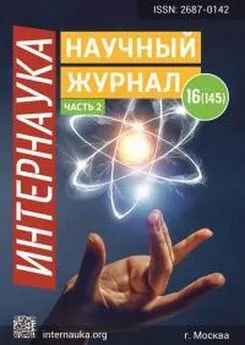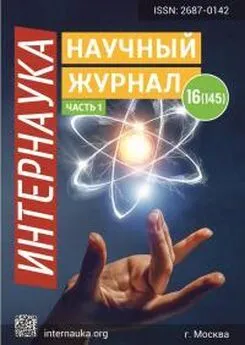Интернаука - Интернаука №16 (часть3) 2020
- Название:Интернаука №16 (часть3) 2020
- Автор:
- Жанр:
- Издательство:COMPANY BY ANA4220
- Год:2020
- ISBN:2687-0142
- Рейтинг:
- Избранное:Добавить в избранное
-
Отзывы:
-
Ваша оценка:
Интернаука - Интернаука №16 (часть3) 2020 краткое содержание
Интернаука №16 (часть3) 2020 - читать онлайн бесплатно полную версию (весь текст целиком)
Интервал:
Закладка:
design and presentation of scientific knowledge.
• adverbs expressing certainty (certainly, in fact),
Certainty and clarity in the scientific discourse is
probability (apparently, perhaps, possibly), attitude
obtained by using the terms that arise carriers and cus-
(amazingly, surprisingly), approach (according to, gen-
todians of certain information in the field of scientific erally, typically);
communication[8].
• pointers of many (all, most, many, some, certain,
Perfect verbs are rarely used, often in steady turns etc.);
(we prove, we consider ...; what ...; we will do conclu-
• complex sentences using verbs expressing the re-
sions; we will show by examples, etc.). Such forms of lation (It appears that, It might be suggested that ...), the verb are used without the subject, are used to call the
adjectives expressing the relation (It may be possible to
interlocutor for joint action and sounds with a kind of obtain ...), nouns expressing the relation (It could be the
incentive intonation, and in this regard they are often case that ...);
perceived as special forms of imperative mood, for ex-5) limited expressivity:
ample: we will study; we will check; we will consider;
emotionally expressive adjective (outstanding,
we will prove it. Texts functioning in scientific dis-etc.);
course are characterized by the use of reflexive verbs
forms of superlative adjectives (the most dan-
(with suffix - “ся”), which mean either action as a hall-gerous place, etc.);
mark of an object, or its permanent property, for exam-
adverbs, introductory words, reinforcing and re-
ple: to remain. The generalized character of the texts of
strictive particles, discursive markers (entirely, highly, the scientific style is also expressed in the originality of relatively, significantly, etc.);
the category of person. In scientific speech, usually the
"problematic" questions that draw the reader's pronouns of the 1st and 2nd person are not used (I, you),
attention (What can be done in this case?)[6].
possessive possessions (mine, yours), forms 1 and 2 of The above features indicate that the English-the singular of the verb, indicating that the action is car-
language scientific discourse is characterized along with
ried out by the speaker or the interlocutor. Instead, we functional features that are common to all academic
use the pronoun 1 of the plural person we (the so-called
author's we), “our” possessive pronoun, verbs in the
texts, regardless of their language affiliation. At the same time, specific features that distinguish the tradi-form of the past tense of the plural or in the form of the
tions of the formation of scientific materials in English present (future simple) tense 1 or 2 of the plural[9].
from the requirements for formatting research results
Logical connections between parts of a scientific
adopted in other linguistic and cultural communities
text are expressed using introductory constructions
should be taken into account. The situation with Russian
(words, phrases and sentences) with the meaning of the
scientific discourse is slightly different.
reliability of the message: naturally, of course. Introduc-
Understanding of scientific discourse appeared in
tory words have other meanings, namely assumptions,
the late 1990s. at the scientific school of the Russian for example: probably obvious. In scientific discourse, linguist Chernyavskaya Valeria Evgenievna. The study
introductory constructions also point to a source of in-of scientific discourse has been introduced into the sys-
formation, for example: as Carl Gustav notes; according
tem of methods and principles of text linguistics and put
to Charles Darwin, etc. Using these introductory ele-
into correlation with a wide range of problems of scien-
ments, the order of thoughts and their connection is ob-
tific communication, a methodology for analyzing text
jectified, a conclusion is introduced, the degree of sig-and discourse, a methodology for researching scientific
nificance of the messages, a generalization, for example,
discourse, and an interdisciplinary assessment of the
connectivity is manifested, firstly; secondly; conse-
quality of the scientific result have been implemented.
quently; and finally.
In the linguistic - epistemic concept of Chernyavskaya N.B. Gvishiani and some other researchers distin-V.E. pointed out that the result of cognition is included
guish a separate, independent general scientific lan-
in scientific discourse in only oral (scientific communi-
guage within the framework of the style of scientific cation) or written (monograph, research article, report communication, considering it to be a historical catego-abstracts, dissertation) text [7].
ry. The general scientific style is determined by: "1) the Language as a social phenomenon performs various
development of the scientific thought of a given coun-functions related to a particular area of human activity.
try; 2) the state of the national literary language; 3) the
In the science of language, the classification of func-artistic skill of the author; 3) the intellectual level of the tional styles of the Russian language has entrenched: reader." The general scientific language varies, changes conversational style, scientific style, official-business depending on the subject of which science - humanitari-style, journalistic style, literary and artistic style. It is an or natural - is being described. The language of gen-important to understand that the style of the Russian eral scientific communication with this approach is op-language scientifically determines the content of the life
posed to the terminological language inherent in each of the language at a very high level of generalization, individual field of knowledge [10].
45
Журнал «Интернаука»
№ 16 (145), часть 3, 2020 г.
Thus, a scientific text acts as a reflection and ex-reflect the patterns of the cognitive process. The content
pression of a scientific style - a special method of cogni-
of the scientific text is revealed using various linguistic
tive and communicative - speech actions of a subject means, among which predominant are sensory (emo-who decides in the process of creating a text to com-tionally neutral), which perform representative and des-
municate new knowledge about reality and to prove the
ignating functions, which indicates the observance of
truth of this knowledge. Considering the above, the pro-
the characteristic linguistic features of the scientific cesses of text generation in scientific speech necessarily
discourse of its basic goals.
References:
1. Koyalan, A., Mumford, S. Changes to English as an Additional Language writers' research articles: From spoken to written register [Text] // English for Specific Purposes. – 2011. – № 30. – P. 113 123.
2. Biber, D., Gray, B. Challenging stereotypes about academic writing: Complexity, elaboration, explicitness [Text] //
Journal of English for Academic Purposes. – 2010. – № 9. – P. 2 20.
3. Martinez, llliana A. Impersonality in the research article as revealed by analysis of the transitivity structure [Text] //
English for Specific Purposes. – 2011. – № 20. – p. 227 247.
4. Pospelova, G. B. Harakteristiki nauchnogo stilja v anglijskom jazyke [Tekst] / G. B. Pospelova // Inostrannye jazyki: teorija i praktika. – M. : Izd-vo «OOO TEZAURUS», 2012. – № 2 (15). – p. 8 14.
5. Halliday, M. A. K., Hasan, R. Cohesion in English [Text]. – London : Longman, 1976. 356 p 6. Kubryakova E.S. On the concept of discourse and discursive analysis in modern linguistics (review) // Discourse, speech, speech activity. Functional and structural aspects: Sat. reviews. - M. INION RAS, 2000 .-- p. 7-25.
7. Drozdova T.V. The problem of understanding the scientific text // Traditional problems of linguistics in the light of new paradigms of knowledge: Materials of the round table, April 2000 / Institute of Linguistics, RAS, TSU im.
G.G. Derzhavina. - M .: Institute of Linguistics, RAS 2000. - p. 49-58.
8. Vargina, E.I. Scientific text and its impact (on the material of the English language) [Text] / E.I. Vargina. - St. Petersburg: Fil. Faculty of St. Petersburg State University, 2004.
9. Bolshakova EI On the principles of building a computer dictionary of general scientific vocabulary // Proceedings of the International Workshop Dialogue ‘2002 on comp. linguistics and intelligence. technology. M., 2002, T. 1, p.
19-23.
10. Gaidenko P.P. Scientific rationality and philosophical mind. M., 2003, p.73-78.
46
Журнал «Интернаука»
№ 16 (145), часть 3, 2020 г.
CHEMISTRY
SYNTHESIS OF TBP-ST-DVB EXTRACTANT POLYMER RESIN AND SEPARATION
OF RADIOACTIVE GALLIUM CHLORIDE
Kim Chung Hyok
Candidate of chemical sciences, Kim Il Sung University,
DPRK, Pyongyang
Im Jon Gil
Doctor of chemical sciences, associate Professor, Kim Il Sung University, DPRK, Pyongyang
Pak Ho Song
Candidate of chemical sciences, Kim Il Sung University,
DPRK, Pyongyang
ABSTRACT
TBP-St-DVB extractant polymer resin was prepared from tri-butylphosphate, styrene and divinylbenzene by suspension polymerization. On extraction chromatograph column, while kinetic process of Ga extraction could be assumed to be simultaneous process of film diffusion and gel diffusion, activation energy of Ga extractive reaction on column was E*=14.92kJ·mol-1.
Keyword:extractant, polymer resin, synthesis, Gallium, Zinc, separation.
1. Introduction
2.2. Extraction of Ga and Zn with TBP-St-DVB ex-
Extractant polymer resins are new type of separa-
tractant polymer resin
tion functional materials that have advantages of solvent
Static condition
extraction and ion exchange technology and overcome
First, extractant resin was swollen in 1mol·L-1 HCl
disadvantages of those.
solution for 24h. Then 1mL of 67Ga solution
In early papers, kinetics of Ga separation by TBP-
(40kBq·mL-1) was injected into 10mL of hydrochloride
St-DVB extractant polymer resin was not studied.
acid solution (concentration of Ga ion; 20mg·L-1) and In this paper, results of kinetic research about 67Ga
mixed. 1g of extractant resin (TBP concentration 30%, separation on hydrochloride solution from Zn target
granular size 0.3~0.4mm) was applied into solution and
bombed by ion beam accelerator were described based
mixed at 60rpm. Equilibrium time was determined when
on synthesizing TBP-St-DVB extractant polymer resin
radioactivity of solution didn’t change by time.
containing TBP as extractant.
Dynamic condition
2. Experimental
A glass column (0.8×25cm) was packed with 0.8g
2.1. Synthesis of TBP-St-DVB extractant polymer
of swollen 30% TBP-St-DVB extractant resin and
resin
washed with HCl solution.
Synthesis of extractant polymer resin containing
GaCl3/6mol·L-1 HCl solution was flown through the
30% TBP was carried out in glass reactor supplied by a
column at flow rate of 1mL·min-1 to extract 67Ga. After
Читать дальшеИнтервал:
Закладка:


